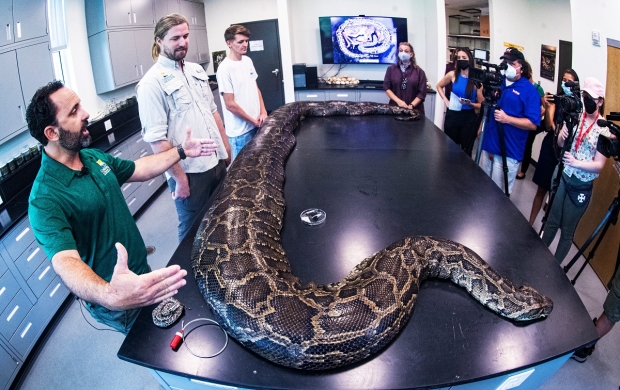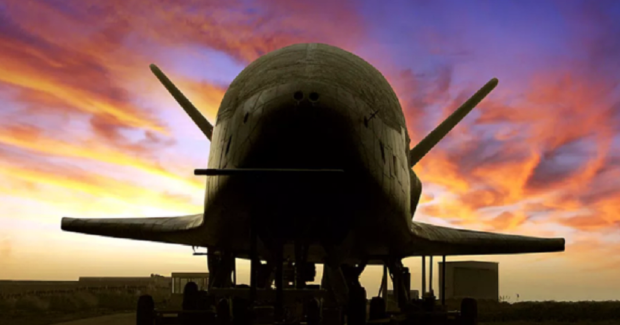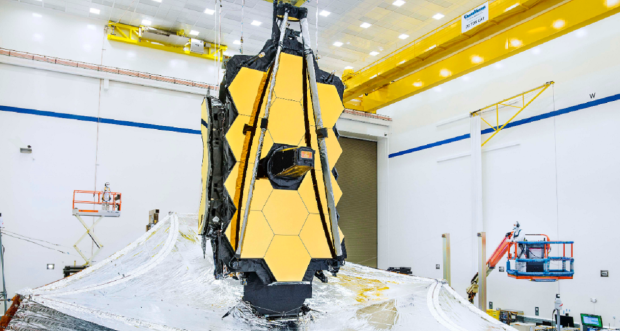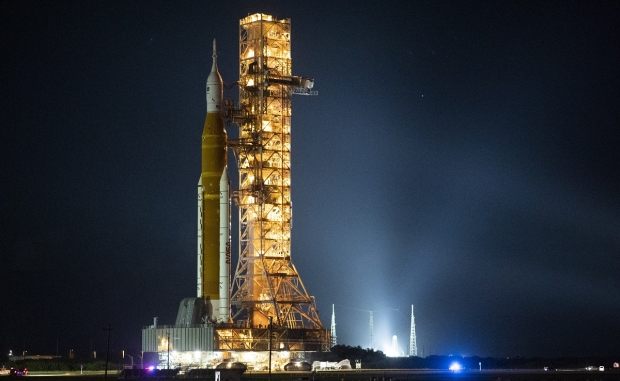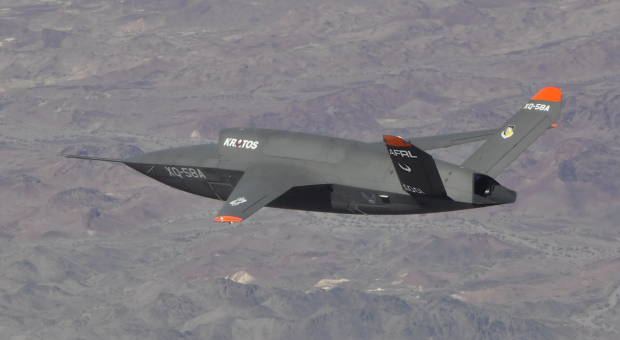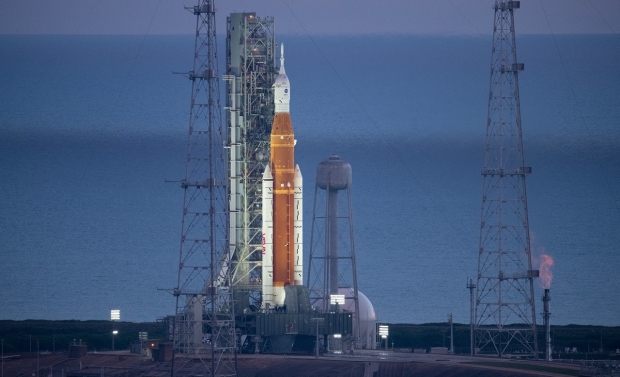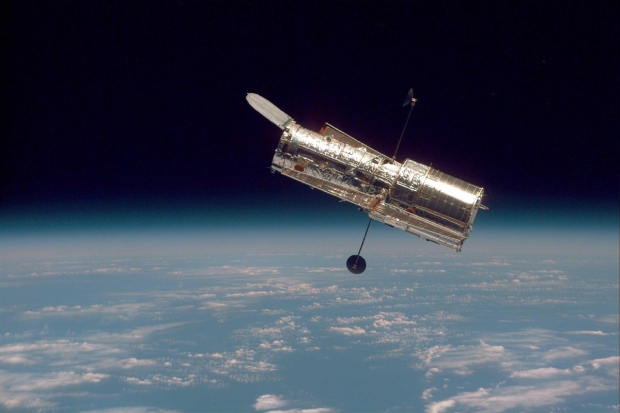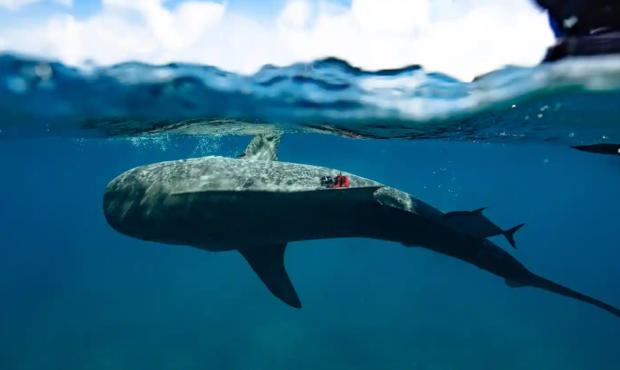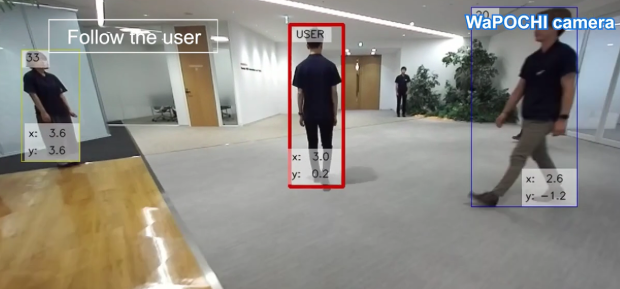Science, Space, Health & Robotics News - Page 75
Scientists release video of 5-foot alligator being cut out of Florida python
A group of scientists discovered a massive Burmese python had a significant lump in its stomach. This python was euthanized for science and dissected.
The group of five scientists, including Rosie Moore, geoscientists based in Florida, took to social media on November 1 by posting a video to Moore's Instagram account that showcased the massive 18-foot-long python being de-skinned and eventually cut open to reveal it had consumed a 5-foot-long alligator that was mostly still intact. Moore spoke to CNN and said that the researchers were taking breaks during the dissection process just to get away from the smell. Moore said she thought it was "pretty gross too".
Secret US space plane finally lands back on Earth after milestone 908-day flight
It was only last week that the US military's X-37B space plane reached a milestone number of days in orbit while on its mysterious mission.
The X-37B space plane that has captured much attention is called Orbital Test Vehicle 6, or OTV-6, and was launched from Cape Canaveral Space Force Station in Florida on May 17, 2020. OTV-6 is the sixth space plane launched under program, with the first being launched in 2010, spending just 224 days in orbit, and the last being OTV-5, which launched in 2017 and spent 780 days in orbit. Now, OTV-6 has broken that record when it touched back down at NASA's Kennedy Space Center in Florida on Saturday, November 12, completing 908 days in orbit.
The mystery behind the space plane is widely known as the majority of its contents, equipment, mission objectives, etc, are classified, with only a few details being given to the public. What is known is that Boeing constructed OVT-6 and that during its time in orbit, it deployed the FalconSat-8 that's developed by the US Air Force Academy, which is carrying its own experimental payloads counting five, as well as the Naval Research Laboratory's photovoltaic radiofrequency antenna module, which is an antenna designed to convert solar power into radio frequency microwave energy.
NASA showcases the incredible power of Webb being able to see faint stars
NASA has taken to its blog to share an image that showcases a beautiful side-by-side comparison between the James Webb Space Telescope and the Spitzer Space Telescope's Infrared Array Camera.
NASA has posted a new blog where it details images of a dwarf galaxy called WLM, which is quite close to our Milky Way galaxy at approximately 3 million light-years from Earth.
NASA spoke with Kristen McQuinn of Rutgers University, one of the lead scientists on Webb Early Release Science (ERS) program that focusses on stellar populations, who explained that WLM is a prime candidate for scientists to test theory theories of galaxy formation as WLM is believed to be barely influenced by other galaxies.
NASA's Artemis rocket survives storm and is still on track to launch soon
NASA has taken to its blog and social channels to update the public on the Space Launch System (SLS) rocket and its Artemis 1 mission.
NASA explains via an update on its website that teams have conducted an assessment of the rocket while it remains upright at Launch Complex 39B at the Kennedy Space Center in Florida, and according to the agency, it can confirm that was no significant impacts to either the rocket or the Orion capsule from Hurricane Nicole. Notably, Hurricane Nicole made landfall approximately 70 miles from the space center, and NASA"s teams used the launch pads sensors and high-resolution cameras to perform the inspection.
Furthermore, Space Launch System engineers have conducted an analysis of the rocket to determine if the high-speed winds it endured won't impact its overall structural strength, and they found no such effect. NASA notes that all of the recorded peak winds during the height of the storm remained below 75% of the SLS design limitations, hence NASA's prior decision to leave the rocket out on the launch pad before the storm made landfall as it believed the rocket could easily weather it. The space agency does report some minor damage with loose caulk and weather coverings, which are both being repaired.
US Air Force testing experimental autonomous stealthy combat aerial vehicle
The US Air Force and Kratos Defense & Security Solutions recently tested the XQ-58A Valkyrie unmanned aircraft. Kratos says the tactical unmanned aerial system (UAS) mixes long-range, high-speed, and maneuverability in a single platform - operating in the low-cost attritable aircraft technology (LCAAT) project.
The unmanned system is 30 ft. in length, with a total wingspan of 27 ft. - and has a dry weight of 2,500 lb. It'll cost $2-$3 million per aircraft, according to Kratos, with the price depending on the number of units ordered.
Kratos said the successful test flight is important as part of the US Air Force Research Laboratory's Autonomous Collaborative Enabling Technologies (ACET) portfolio. It was able to successfully land inside a designated target zone, despite a simulated loss of communications - demonstrating effective autonomous capability.
Scientists detect a middle weight black hole devouring a star out in deep space
Scientists have detected a black hole more than a million light years away from Earth engulfing a star, causing what researchers refer to as a "Tidal Disruption Event".
The new study published in the scientific journal Nature Astronomy details that Tidal Disruption Events happen when a black hole sucks up a nearby star, essentially shredding all of its available matter and energy much like a paper being put through a shredder. Throughout this process a blast of radiation and energy can be released by the black hole and that's exactly what caught astronomers' eyes when this middle-weight black hole consumed a star within the distant dwarf galaxy.
Researchers believe that measuring the blast of radiation will allow them to learn more about black holes and their relationship within dwarf galaxies. In particular, the researchers say that blast caused by the Tidal Disruption Event can provide insight into how researchers measure black hole in the future as well as how black holes go about consuming nearby stars.
NASA gives update on Artemis rocket after it's smacked by a powerful storm
NASA's Artemis 1 vehicle was positioned on Launch Pad 39B at NASA's Kennedy Space Center when it was smacked by maelstrom Nicole.
Nicole hit NASA's Space Launch System (SLS) rocket with the attached Orion capsule on November 10, and as it rolled in from the coast, it was deemed a Category 1 hurricane but later changed to a weakened tropical storm as it moved more inland. NASA officials have reported that the Artemis 1 rocket and Orion capsule have experienced high-speed winds and rain but have made it through the several hours of panic with minimal damage.
According to reports, sensors located at the Launch Pad 39B indicate that wind speed peaked at around 82 mph while at an altitude of 60 feet, which is actually within the rocket's designed capabilities. According to a statement from NASA on November 8, the SLS rocket is designed to withstand wind speeds of up to 85 mph at 60 feet - talk about a close call.
NASA releases images of its telescope capturing the moment a star exploded
NASA's Hubble Space Telescope, which has been in operational service for 32 years and counting, witnessed the moment a star started exploding more than 11 billion years ago.
A new study published in the scientific journal Nature details a team of astronomers combing through Hubble's observational data from 2010 when they realized that the space telescope witnessed a star exploding. Notably, NASA explains on its website that witnessing a star exploding, or more accurately, going supernova, is actually quite a rare event as the period of time that it can be detected ranges from a few hours to just a few days. Hubble managed to capture a sequence of images that show the progression of the supernova.
NASA explains in its blog post on its website that this supernova happened when the universe was extremely young, less than a fifth of its current age of 13.8 billion years. Furthermore, the space agency writes that the observation wouldn't have been possible without a phenomenon called gravitation lensing, which was caused by the galaxy cluster Abell 370.
Cameras attached to sharks discover unexplored underwater forest
A team of researchers attached cameras to a group of Tiger sharks to study the ocean floor, and what they discovered was amazing.
The new study published in the scientific journal Nature Communications details a group of scientists attaching cameras and trackers to the dorsal fins of several Tiger sharks. These sharks then led the researchers to an incredible seabed in the Caribbean. The study explains that the sharks led the researchers to an underwater forest of seagrass that the team believes is approximately 35,000 miles in diameter. The authors behind the study say the discovery is a representation of how little humans know about the ocean.
There isn't much knowledge on seagrass, but scientists do know that underwater forests of it are a prime feeding ground for marine life, while the forests also double as a storage facility for large amounts of carbon. Since underwater forests of seagrass are so vast, and are incredible for storing carbon, researchers believe studying these forests will influence humans' overall fight against climate change and slow its effects. Studying underwater forests of seagrass will allow scientists to understand how the carbon it's storing affects the planet.
Continue reading: Cameras attached to sharks discover unexplored underwater forest (full post)
Honda develops new AI platform, wants humans and machines to better interact
Honda is now publicly demonstrating its own artificial intelligence platform which relies on the company's cooperative intelligence efforts. Honda CI is designed to help humans and robots coexist in a productive manner. An autonomous short-distance people mover/taxi type model was also shown off, with development continuing into 2023.
Honda has several different potential use cases for Honda CI, which include robots, an autonomous transportation vehicle, and more. It remains to be seen if any of these services will make it to actual real-world use, but it's neat to see automakers branching out.
The WaPOCHI electric micro-mobility robot can follow designated users, with the person identified based on palm vein authentication - and can learn and recognize distinctive physical features of each user. Although this might seem overly creepy, the operator is able to go about daily tasks while the robot is able to ferry items around for the user.


